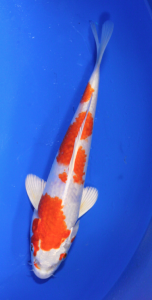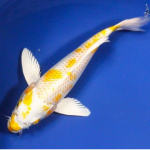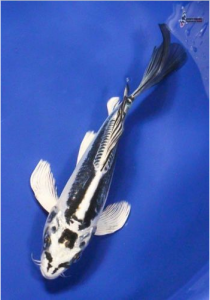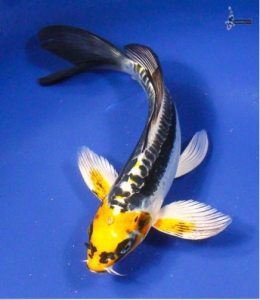Pronounced hee-KAH-ree-MOH-yoh, this classification of koi fish is a multi-colored metallic koi with a white (platinum) base. If a metallic koi doesn’t fit into either the Hikarimuji or Hikariutsuri classifications, then you will find it in the Hikarimoyo category.
It encompasses a number of different breeds boasting two or more colors. They are renowned for their striking colorations against a metallic background both in the scaled or scaleless (doitsu) versions.
Given the overall beauty of their luster and brightness of the colors, it is a popular type of koi fish amongst enthusiasts—and one that continues to grow in popularity.
Hariwake (HAH-ree-WAH-keh)

Hariwake koi are descendants of the Hikarimuji class’s Ogon (or Ogon Matsuba) koi. They are a metallic, two-colored koi with the characteristic platinum base overlaid with either areas of metallic orange (orenji) or yellow (yamabuki).
With the different color combinations available, there are quite a few sub-varieties to choose from (including the “pine cone” scale reticulation of the Matsuba).
The Lemon Hariwake sub-variety, with the simplicity of the clean white base and crisp yellow overlay, is a popular choice amongst U.S. koi fish enthusiasts. The butterfly finnage can also be a nice addition to this sub-category.

Features to look for:
- Undiluted platinum base (no off-color tinting)
- Platinum fins (some secondary coloration may be present on the pectoral fins)
- Platinum head (or if there is a secondary color, it shouldn’t cover the whole head)
- Unblurred scale edging between the two colors
Kikusui (KEE-koo-swee)

Kikusui (meaning “water chrysanthemum”) are a metallic doitsu (scaleless) versions of the Hariwake.
This category of koi is sometimes broadly referred to as “Doitsu Hariwake”; however, it is ordinarily only those koi that that exhibit a deep orange coloration, bordering on red (similar to the Kohaku) that are dubbed Kikusui.
If the color is less orange (or more yellow) they are usually considered Doitsu Lemon (yamabuki) Hariwake.
Features to look for: (similar to the Hariwake):
- Undiluted platinum base (no off-color tinting)
- Deep, consistent orange coloration in all patterns across the body
- Platinum head (or if there is a secondary color, it shouldn’t cover the whole head)
- Platinum fins (some secondary coloration may be present on the pectoral fins)
Kujaku (koo-JAH-koo)

Kujaku (meaning “peacock”) have the platinum white bodies with an overlaid secondary color (red, orange or yellow/gold) and then a Matsuba-like black pine cone netting scalation.
In the Kujaku sub-category, there is also a doitsu (scaleless) sub-category where the body takes on a blue color against the red, orange and yellow.
Another common feature of the doitsu Kujaku is the “zipper” scale pattern that runs the length of the dorsal portion of the body. It is a good distinguishing mark for the doitsu Kujaku to differentiate it from the Kin Kikokuryu.
Features to look for:
- symmetrical and consistent pine cone scalation (not heavy in one area and absent in others)
- Unblurred scale edging between the two colors (base and secondary red, orange or yellow)
- Platinum head (or if there is a secondary color, it should be an interesting pattern with no black in it and shouldn’t cover the whole head)
Kikokuryu (KEE-koh-KOO-droo)

Kikokuryu (meaning “Chrysanthemum water”) are a fairly recent addition to the koi family and are essentially a metallic Kumonryu. The combination of Kumonryu and Platinum Ogon, they are a metallic doitsu (scaleless) koi with black over white coloration.
Like its parent Kumonryu, the Kikokuryu will change colors over the course of its lifetime, so a two-year-old fish will be different than its six-month-old self. It can also exhibit patterns on the head similar to ghost koi. A strong red pattern on a Kikokuryu are also known as Beni Kikokuryu.
Features to look for:
- Bright platinum whites and shiny lacquer blacks
- Body shape
- Color quality over pattern
Kin Kikokuryu (keen-KEE-koh-KOO-droo)

Kin Kikokuryu, a variation of the Kikokuryu, is another newcomer (created in the late 1990s). It adds a metallic red, yellow or orange to the existing scaleless black and white colors of the Kikokuryu.
Features to look for:
- body-wide underlying black pattern (including mouth, fins and head)
- flawless sumi (black markings) and overlaid white colors
- Body shape
- Color quality
- Good orange, red or yellow patterns (least likely to change color over time)
Yamato Nishiki (YAH-mah-toh-nee-SHEE-kee)

Yamato Nishiki are a vibrantly colored metallic Sanke and are quite rare, making a high quality specimen difficult to obtain.
Features to look for:
- Solid, flawless and untinted platinum white base
- Evenly spaced black patterns across the body (no concentrated in one area) with no color showing inside the pattern
- Bright and consistent orange that doesn’t encroach onto the head or nose
Heisei Nishiki (HAY-say-nee-SHEE-kee)

Heisei Nishiki are a scaleless (doitsu) Yamato Nishiki. This essentially makes them a metallic, scaleless Taisho Sanke. Another relative youngster to the koi world, it is another sub-category that is not not easy to find.
Features to look for (similar to the Yamato Nishiki):
- Solid, flawless and untinted platinum white base
- Evenly spaced black patterns across the body (not concentrated in one area) with no color showing inside the pattern
- Bright and consistent orange that doesn’t encroach onto the head or nose
NextDayKoi.com can help to stock our pond with your favorite Hikarimoyo koi fish as well as a huge range of other different types of koi fish on offer. Coupled with a great selection of both sizes and types, we leverage our high volume of shipping through UPS to bring you some of the most competitive Next Day Air shipping rates in the industry.
Contact one of our representatives to see how we can help you stock your pond.

